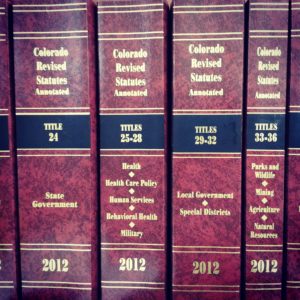by Jessica Herrera
Is the drafter in the room? We have a statutory interpretation question about a series of words.
In a perfect world, all statutes would have a plain and straightforward meaning. Unfortunately, there are times when there is ambiguity in the words or phrases of a statute, and courts will rely on various methods of statutory interpretation. One way courts discern what a statute means is by using canons of statutory construction. These canons of statutory construction are interpretive principles that drafters in the Office of Legislative Legal Services often consider when drafting bills. Although these canons of statutory construction are not absolute, and may at times even conflict with one another, they are nevertheless a tool in your favorite drafter’s tool box.

Canons of Statutory Constructions Regarding a List or Series of Words
Expressio Unius est Exclusio Alterius
Starting off with the most common sense canon of statutory construction, the doctrine of expressio unius est exclusio alterius comes from the Latin phrase that means “the express mention of one person or thing excludes others.” This canon boils down to the presumption that specified enumerations in a statute restrict the meaning to just those expressly listed. To illustrate, a statute that prohibits an individual from intentionally “hitting, kicking, or stomping” on a dog would exclude the prohibition of other harmful acts, such as strangling a dog, even if the legislative intent is obviously to prevent actions of a similar nature. Would adding a broader, catch-all clause at the end help prevent other harmful acts to dogs? It depends. The next canon of statutory construction sheds some light on having a catch-all clause at the end of a sentence.
Ejusdem Generis
Ejusdem Generis is a canon of statutory construction that comes from the Latin phrase that means “of the same kind.” Ejusdem Generis is the doctrine that states where there is a list or a series that specifies a number of specific people or things, and the list is immediately followed by more general words or a phrase, the general words or phrase is construed as being limited in scope and applies only to people or things of the same kind or class as those expressly mentioned with particularity. For example, if a law refers to automobiles, trucks, tractors, motorcycles, and other motor-power vehicles, a court applying the principle of ejusdem generis to the general phase of “motor-power vehicles” would likely exclude a boat or airplane because the specified list was limited to land-based vehicles.[1] In essence, it is worthwhile to pay attention to a common theme in an enumerated list, as a court may limit the scope of a catch-all phrase to a specific characteristic. See more about Ejusdem Generis here.
The Last Antecedent Rule and the Series Qualifier Battle
As we all recall from primary school, an antecedent is a word that is replaced by another word in the course of a sentence. The most common occurrence is when an antecedent is replaced by a pronoun. For example in the sentence, “Rose is very smart, she would make a great public official!” “Rose” is the antecedent to the pronoun “she.” Now that we all remember what an antecedent is, let’s extrapolate the concept of an antecedent to the canon of statutory construction known as the last antecedent.
Under the last antecedent rule, when a series is followed by words of limitation, the limitation will apply only to the last antecedent on the list. For instance, a statute may provide, “Licensees may hunt deer, moose, and fish that are not on the endangered species list.” The restriction “that are not on the endangered species list” will apply only to fish, which is the last antecedent on the list. The last anteceding rule applies to qualifiers that follow a list.
If a qualifier precedes a list, the series qualifier cannon applies. For instance, a statute may provide “Licenses may hunt blue deer, moose, and fish.” Under the series qualifier canon, the qualifier blue applies to fish as well as to deer and moose.
If the last antecedent rule appears familiar to you, that may be due to your diligent reading on construction of statutes found in part 2 of article 4 of title 2, C.R.S. Specifically, section 2-4-214,C.R.S., states that the last antecedent rule has not been adopted by the general assembly. That means the modifier is not presumed to apply to just the last item on the list. Although the last antecedent rule may have had its last hurrah in Colorado, it is still used in other states and notably in the recent United States Supreme Court case Lockhart v. United States. [2]
The court in Lockhart interpreted the federal law that set forth a mandatory minimum sentencing for an individual who violated federal law regarding possession of child pornography and also had a prior conviction under “…the laws of any state relating to aggravated sexual abuse, sexual abuse, or abusive sexual conduct involving a minor or ward…” The question at issue in Lockhart was whether the qualifier “involving a minor or ward” applied only to the last antecedent, “abusive sexual conduct,” or whether it also applied to the whole series and thus included both “aggravated sexual abuse” and “sexual abuse.” If the qualifier “involving a minor or ward” applied to the entire series, the defendant’s prior conviction of sexual abuse did not subject him to federal statute’s mandatory minimum sentencing because the victim was not a minor or ward. The Supreme Court held that the qualifier applied only to the last antecedent and not the whole series, and thus Lockhart’s prior conviction of sexual abuse perpetrated upon an adult elevated his minimum sentencing.
These canons of statutory construction can play a role in determining whether something on a list or series is included or excluded and used as a tool to decipher the legislature’s intent. Sometimes making a list or series in statute is not as straightforward as one would think. Given the potential ambiguity and unintended legislative intent that may be implied from a series with a modifier, it might be best to forgo including a modifier all together and instead opt to flesh out each item on a list independently as suggested here.
[1] McBoyle v. United States, 283 U.S. 25 (1931)
[2] Lockhart v. United States, 577 U.S. 347 (2016)







